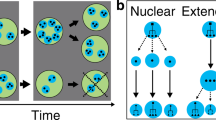Summary
On the basis of a family reconstitution study (Krummhörn, Germany, 18th und 19th centuries) it is shown how in one marriage cohort (1720–1750), family land ownership correlates with systematic fitness differentials. Farmers have a greater long-term fitness, on the average, than members of non-peasant population, and farmers possessing better than average wealth achieve a greater long-term fitness than farmers with medium-sized or small landholdings. The proximate causes herefore are to be found in both the varying patterns of marital fertility and in the differences in the marital and migration habits of the children from the various social groups. That is why the number of live births or even the number of surviving children is not the best estimate of a person's genetic contribution to the next generation of the local population. This can be shown by using a new algorithm for the assessment of long-term fitness differentials.
Similar content being viewed by others
References
Ajami I (1976) Differential fertility in peasant communities: A study of six Iranian villages. Population Studies 30:453–463
Boone III JL (1988) Parental investment, social subordination and population processes among the 15th and 16th century Portuguese nobility. In: Betzig LL, Borgerhoff Mulder M, Turke P(eds) Human reproductive behaviour — A Darwinian perspective. Cambridge Univ Press, Cambridge, pp 201–219
Borgerhoff Mulder M (1987a) Adaptation and evolutionary approaches to anthropology. Man (N.S.) 22:25–41
Borgerhoff Mulder M (1987b) On cultural and reproductive success: Kipsigis evidence. Am Anthropol 89:617–634
Bourdieu P (1962) Célibat et condition paysanne. Études rurales 5–6:32–135
Comins HN, Hamilton WD, May RM (1980) Evolutionarily stable dispersal strategies. J Theor Biol 82:205–230
Crook JH, Crook SJ (1988) Tibetan polyandry: Problems of adaptation and fitness. In: Betzig LL, Borgerhoff Mulder M, Turke P (eds) Human reproductive behaviour — A Darwinian perspective. Cambridge Univ:Press, Cambridge, pp 97–114
D'Argemir D (1987) Rural crisis and the reproduction of family systems — Celibacy as a problem in the Aragonese Pyrenees. Sociologia ruralis 27:263–277
Dupâquier J, Hélin E, Laslett P, Livi-Bacci M, Sogner S (eds) (1981) Marriage and remarriage in populations of the past. Academic Press, London, pp 591–604
Endler JA (1986) Natural selection in the wild. Princeton Univ Press, Princeton, NJ
Essock-Vitale SM (1984) The reproductive success of wealthy Americans. Ethol Sociobiol 5:45–49
Faux SF, Miller Jr HL (1984) Evolutionary speculations on the oligarchic development of Mormon polygyny. Ethol Sociobiol 5:15–31
Fisher RA (1930) The genetical theory of natural selection. Clarendon, Oxford
Flinn MV (1986) Correlates of reproductive success in a Caribbean Village. Hum Ecol 14: 225–243
Flinn MW (1981) The European demographic system, 1500–1820. Johns Hopkins Univ Press, Baltimore, MD
Greenwood PJ (1983) Mating systems and the evolutionary consequences of dispersal. In: Swingland IR, Greenwood PJ (eds) The ecology of animal movement. Clarendon, Oxford, pp 116–131
Hamilton WD, May RM (1977) Dispersal in stable habitats. Nature 269:578–581
Henry L (1980) Techniques d'analyse en démographie historique. Paris
Horn HS (1983) Some theories about dispersal. In: Swingland IR, Greenwood PJ (eds) The ecology of animal movement. Clarendon, Oxford, pp 54–62
Hughes AL (1986) Reproductive success and occupational class in eighteenth-century Lancashire, England. Soc Biol 33:109–115
Irons W (1979) Cultural and biological success. In: Chagnon NA, Irons W (eds) Evolutionary biology and human social behavior — An anthropological perspective. Duxbury, North Scituate, pp 257–272
Kaplan H, Hill K (1985) Hunting ability and reproductive success among male Ache foragers: Preliminary results. Curr Anthrop 26:131–133
Kaplan H, Hill K (1986) Sexual strategies and social-class differences in fitness in modern industrial societies. Behav Brain Sci 9:198–201
Klöpper R (1949) Die Bevölkerungsentwicklung in den ostfriesischen Marschen. Deutsche Geogr Blätter 45:37–77
Mealey L (1985) The relationship between social status and biological success: A case study of the Mormon religious hierarchy. Ethol Sociobiol 6:249–257
Shaikh K, Becker S (1985) Socioeconomic status and fertility in rural Bangladesh. J Biosocial Sci 17:81–89
Shields MW (1982) Philopatry, inbreeding and the evolution of sex. SUNY Press, Albany NY
Stephan P (1983) Bevölkerungsbiologische Untersuchungen in Ditfurt, einem Dorf im Nordharzvorland, im 17. und 18. Jahrhundert. unpubl Diss, Akademie der Wissenschaften der DDR
Stys W (1957) The influence of economic conditions on the fertility of peasant women. Popul Stud 11:136–148
Thaller M (1988) Kleio - Ein fachspezifisches Datenbanksystem fur die Historischen Wissenschaften. Max-Planck-Inst f Geschichte, Göttingen
Turke PW, Betzig LL (1985) Those who can do: Wealth, status, and reproductive success on Ifaluk. Ethol Sociobiol 6: 79–87
Vining Jr DR (1986) Social versus reproductive success: The central theoretical problem of human sociobiology. Behav Brain Sci 9:167–216
Voland E (1989) Differential parental investment: Some ideas on the contact area of European social history and evolutionary biology. In: Standen V, Foley RA (eds) Comparative socioecology: The behavioural ecology of humans and other mammals, Blackwell, Oxford, pp 391–403
Voland E, Engel C (in press) Female choice in humans: a conditional mate selection strategy of the Krummhörn women (Germany 1720–1874). Ethology
Author information
Authors and Affiliations
Rights and permissions
About this article
Cite this article
Voland, E. Differential reproductive success within the Krummhörn population (Germany, 18th and 19th centuries). Behav Ecol Sociobiol 26, 65–72 (1990). https://doi.org/10.1007/BF00174026
Received:
Accepted:
Issue Date:
DOI: https://doi.org/10.1007/BF00174026




